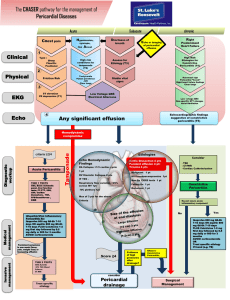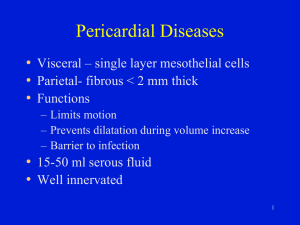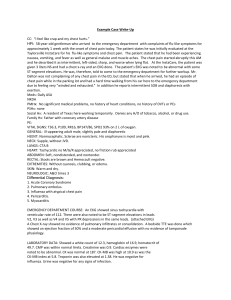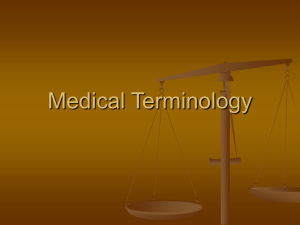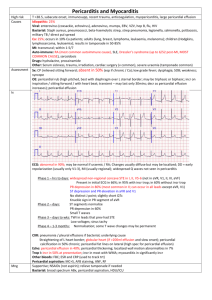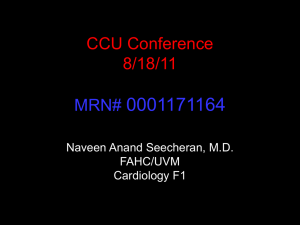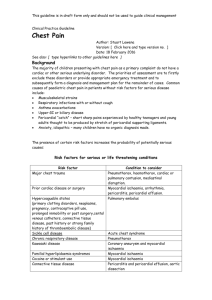Acute pericarditis_01 (Clinical presentation and diagnostic
advertisement
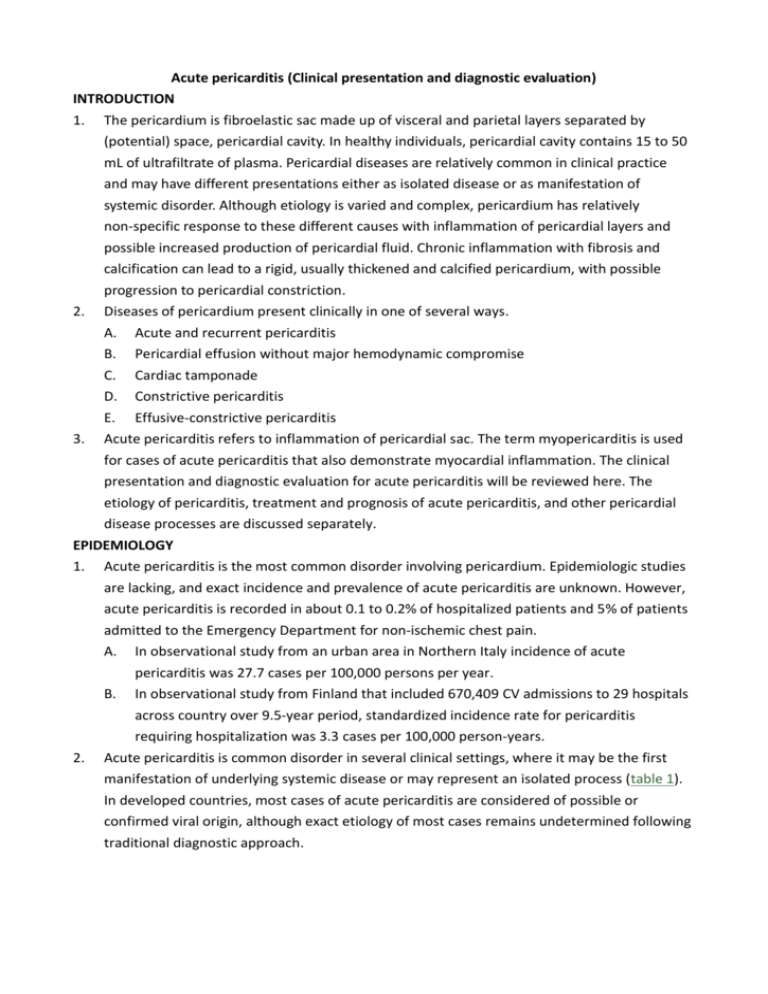
Acute pericarditis (Clinical presentation and diagnostic evaluation) INTRODUCTION 1. The pericardium is fibroelastic sac made up of visceral and parietal layers separated by (potential) space, pericardial cavity. In healthy individuals, pericardial cavity contains 15 to 50 mL of ultrafiltrate of plasma. Pericardial diseases are relatively common in clinical practice and may have different presentations either as isolated disease or as manifestation of systemic disorder. Although etiology is varied and complex, pericardium has relatively non-specific response to these different causes with inflammation of pericardial layers and possible increased production of pericardial fluid. Chronic inflammation with fibrosis and calcification can lead to a rigid, usually thickened and calcified pericardium, with possible progression to pericardial constriction. 2. Diseases of pericardium present clinically in one of several ways. A. Acute and recurrent pericarditis B. Pericardial effusion without major hemodynamic compromise C. Cardiac tamponade D. Constrictive pericarditis E. Effusive-constrictive pericarditis Acute pericarditis refers to inflammation of pericardial sac. The term myopericarditis is used for cases of acute pericarditis that also demonstrate myocardial inflammation. The clinical presentation and diagnostic evaluation for acute pericarditis will be reviewed here. The etiology of pericarditis, treatment and prognosis of acute pericarditis, and other pericardial 3. disease processes are discussed separately. EPIDEMIOLOGY 1. Acute pericarditis is the most common disorder involving pericardium. Epidemiologic studies are lacking, and exact incidence and prevalence of acute pericarditis are unknown. However, acute pericarditis is recorded in about 0.1 to 0.2% of hospitalized patients and 5% of patients admitted to the Emergency Department for non-ischemic chest pain. A. In observational study from an urban area in Northern Italy incidence of acute pericarditis was 27.7 cases per 100,000 persons per year. B. In observational study from Finland that included 670,409 CV admissions to 29 hospitals across country over 9.5-year period, standardized incidence rate for pericarditis 2. requiring hospitalization was 3.3 cases per 100,000 person-years. Acute pericarditis is common disorder in several clinical settings, where it may be the first manifestation of underlying systemic disease or may represent an isolated process (table 1). In developed countries, most cases of acute pericarditis are considered of possible or confirmed viral origin, although exact etiology of most cases remains undetermined following traditional diagnostic approach. 3. Prior to widespread availability of antiretroviral therapy to treat infection with HIV, pericardial disease was the most frequent CV manifestation of AIDS. However, in developed countries with access to HIV therapy, patients with HIV infection who develop acute pericarditis have etiologic spectrum very similar to non-HIV infected patients. On contrary, HIV and TB persist as major causes of acute pericarditis in developing countries. CLINICAL FEATURE 1. Acute pericarditis can present in variety of ways, depending on underlying etiology. Patients with infectious etiology may present with S/S of systemic infection such as fever and leukocytosis. Viral etiologies in particular may be preceded by “flu-like” respiratory or GI symptoms. Patients with known autoimmune disorder or malignancy may present with signs or symptoms specific to their underlying disorder. 2. 3. The major clinical manifestations of acute pericarditis. A. Chest pain – typically sharp and pleuritic, improved by sitting up and leaning forward B. Pericardial friction rub – a superficial scratchy or squeaking sound best heard with the diaphragm of the stethoscope over the left sternal border C. ECG changes – new widespread ST elevation or PR depression D. Pericardial effusion Chest pain A. The vast majority of patients with acute pericarditis present with chest pain (> 95% of cases). Chest pain is likely to be present in cases of acute pericarditis caused by infection, but may be minimal or absent in patients with uremic pericarditis or pericarditis B. C. associated with rheumatologic disorder (although in some patients pleuritic chest pain and pericarditis is initial presentation of SLE). Chest pain that results from acute pericarditis is typically fairly sudden in onset and occurs over anterior chest. Unlike pain from myocardial ischemia, chest pain due to pericarditis is most often sharp and pleuritic in nature, with exacerbation by inspiration or coughing. One of the most distinctive features is tendency for decrease in intensity when patient sits up and leans forward. This position (seated, leaning forward) tends to reduce pressure on parietal pericardium, particularly with inspiration, and may also allow for splinting of diaphragm. However, dull, oppressive pain or radiation of pain to shoulders (particularly trapezius ridges) may occur; in such cases it is difficult to distinguish pericarditis from other causes of chest pain. The chest pain of pericarditis must always be distinguished from other common and/or life-threatening causes of chest pain such as AMI, PE, aortic dissection, GERD, and musculoskeletal pain. 4. Pericardial friction rub A. The presence of pericardial friction rub on PE is highly specific for acute pericarditis B. C. D. (movie 1). Pericardial friction rubs, which occur during maximal movement of heart within its pericardial sac, are said to be generated by friction between two inflamed layers of pericardium. However, this commonly offered explanation for its mechanism may be oversimplification as patients with pericardial effusion may also have audible friction rub. The classic friction rub consists of three phases, corresponding to movement of heart during atrial systole (which is not heard in patients with Af), ventricular systole, and rapid filling phase of early ventricular diastole. However, some rubs are present only during one (one component) or two phases (two components) of cardiac cycle. In review of auscultation and phonocardiography in 100 patients with pericardial rub, rub was triphasic in 56% of patients in SR; overall, biphasic rubs were present in 33% and monophasic rubs in 15%. Pericardial rubs have superficial scratchy or squeaking quality that is best heard with diaphragm of stethoscope. They may be localized or widespread, but are usually loudest over left sternal border. The intensity of rub frequently increases after application of firm pressure with diaphragm, during suspended respiration, and with patient leaning forward or resting on elbows and knees. This last maneuver is designed to increase contact between visceral and parietal pericardium, but is seldom used in practice since it is cumbersome for patient. Friction rubs tend to vary in intensity and can come and go over period of hours; therefore, sensitivity for detection of rub is variable and depends in large part on frequency of auscultation. Pericardial rubs may be easier to hear in patients without pericardial effusion, but this finding is not universal and is not well-documented. In report of 100 patients with acute pericarditis, pericardial rub was present in 34 of 40 (85%) without effusion. This prevalence is considerably higher than 35% incidence of friction rubs reported in another series. E. 5. Suspension of respiration during auscultation permits distinction of pericardial friction rub from pleuropericardial or pleural rub. A pleuropericardial rub results from friction between inflamed pleura and parietal pericardium, while pleural rub is result of friction between inflamed visceral and parietal pleura. As such, pleuropericardial and pleural rubs can be heard only during inspiratory phase of respiration. Electrocardiogram A. Changes in ECG in patients with acute pericarditis signify inflammation of epicardium, since parietal pericardium itself is electrically inert. However, some causes of pericarditis do not result in significant inflammation of epicardium and, as such, may not alter ECG. An illustration of this is uremic pericarditis, in which there is prominent fibrin deposition but little or no epicardial inflammation. As result, ECG often shows none of changes associated with pericarditis. B. ECG in acute pericarditis can evolve through as many as four stages of changes. However, pericarditis does not always result in significant ECG changes. One series of 300 consecutive patients with acute pericarditis noted typical ECG evolution in 60% of cases. C. The typical progression of ECG changes in patients with acute pericarditis. i. Stage 1, seen in first hours to days, is characterized by diffuse STE (typically concave up) with reciprocal STD in leads aVR and V1 (waveform 1). There is also atrial current of injury, reflected by elevation of PR segment in lead aVR and depression of PR segment in other limb leads and in left chest leads, primarily V5 and V6. Thus, PR and ST segments typically change in opposite directions. PR segment deviation, which is highly specific though less sensitive, is frequently overlooked. TP segment is recommended as baseline for comparison when measuring both PR and ST segment changes in acute pericarditis. ii. Stage 2, typically seen in the first week, is characterized by normalization of ST and PR segments. iii. Stage 3 is characterized by development of diffuse TWI, generally after ST segments have become isoelectric. However, this stage is not seen in some patients. iv. Stage 4 is represented by normalization of ECG or indefinite persistence of TWI ("chronic" pericarditis). D. The temporal evolution of ECG changes with acute pericarditis is highly variable from E. one patient to another. Treatment can accelerate or alter ECG progression. The duration of ECG changes in pericarditis also depends upon its cause and extent of associated myocardial damage. Atypical ECG changes are seen in up to 40% of patients with acute pericarditis. For example, localized STE and TWI occur before ST-segment normalization in minority of patients with acute pericarditis without myocardial involvement. These changes can simulate ECG changes seen in patients with ACS. F. Sustained arrhythmias are uncommon in acute pericarditis, except in post-thoracotomy setting. This was illustrated in review of 100 consecutive patients in which only 7 arrhythmias were identified; all were atrial and all occurred in patients with underlying heart disease. In separate report comparing patients with myopericarditis and simple acute pericarditis, cardiac arrhythmias were also more commonly present in patients with myopericarditis (OR 17.6). Thus, presence of atrial or ventricular arrhythmias is suggestive of concomitant myocarditis or unrelated cardiac disease. G. ECG differentiation from acute myocardial infarction i. While both acute pericarditis and AMI can present with chest pain and elevations in cardiac biomarkers, ECG changes in acute pericarditis differ from those in STEMI in several ways. These distinctions assume that pericarditis does not occur during or ii. iii. iv. v. vi. soon after AMI. Morphology – STE in acute pericarditis begins at J point, which represents junction between end of QRS complex (termination of depolarization) and beginning of ST segment (onset of ventricular repolarization). STE rarely exceeds 5 mm, and usually retains its normal concavity. In some cases of acute pericarditis, ST segment rises obliquely in straight line. Although similar patterns can occur with STEMI, typical finding in STEMI patient is convex (dome-shaped) STE (pattern not characteristic of acute pericarditis) that may be > 5 mm in height. The basis for these morphologic differences is not known, but is probably related to the greater injury current associated with infarction. Distribution – STE in STEMI are characteristically limited to anatomical groupings of leads that correspond to localized vascular area of infarct (anteroseptal and anterior leads V1 to V4; lateral leads I, aVL, V5, V6; inferior leads II, III, aVF). The pericardium envelops heart, therefore ST changes are more generalized and typically are present in most leads. In pericarditis, STE in precordial leads is most commonly seen in V5 and V6, and in decreasing frequency from V4 to V1, while in limb leads, it is often more evident in leads I and II than in leads III, aVF, and aVL. Reciprocal changes –STEMI is often associated with reciprocal ST segment changes, which are not seen with pericarditis except in leads aVR and V1. Concurrent ST-T changes – STE and TWI do not generally occur simultaneously in pericarditis, while they commonly coexist in STEMI. Furthermore, evolution of repolarization abnormalities often takes place more slowly and more asynchronously among affected leads in pericarditis than in STEMI. Hyperacute T waves – Peaked T waves (> 10mm high in precordial leads, > 5 mm high in limb leads), also referred to as hyperacute T waves, can be seen in STEMI but are not typical of pericarditis. Rarely, fusion of ST segment and T wave into single monophasic wave in pericarditis can mimic appearance of hyperacute T waves. vii. viii. ix. Q waves – Pathologic Q waves, which may occur with extensive injury in STEMI, are generally not seen in pericarditis. The abnormal Q waves in MI reflect loss of positive depolarization voltages because of transmural myocardial necrosis. Pericarditis, on the other hand, generally causes only superficial inflammation. Abnormal Q waves are not seen unless there is concomitant myocarditis or preexisting cardiomyopathy or myocardial infarction. PR segment – PR elevation in aVR with PR depression in other leads due to concomitant atrial current of injury is frequently seen in acute pericarditis but rarely seen in STEMI. QT prolongation – Prolongation of QT interval with regional TWI (in absence of drug effects or relevant metabolic disorders) favors diagnosis of AMI (or myopericarditis) over pericarditis alone. H. ECG differentiation from early repolarization i. The early repolarization variant seen on ECG may be present in as many as 30% of young adults and is often confused with acute pericarditis. Early repolarization is characterized by STE of J point, which represents junction between end of QRS complex (termination of depolarization) and beginning of ST segment (onset of ventricular repolarization). As result, there is STE segment itself, which maintains its normal configuration (waveform 4). In early repolarization, STE is most often present in anterior and lateral chest leads (V3-V6), although other leads can be involved. ii. 6. The following ECG features can be helpful in distinguishing acute pericarditis from early repolarization. 1. STE occur in both limb and precordial leads in most cases of acute pericarditis (47 of 48 in one study), whereas about 50% of subjects with early repolarization have no ST deviations in limb leads. 2. PR deviation and evolution of ST and T changes strongly favor pericarditis, as neither is seen in early repolarization. 3. If ratio of STE to T wave amplitude in lead V6 exceeds 0.24, acute pericarditis is present (PPV and NPV are both 100%). Laboratory and imaging findings A. Echocardiogram i. UCG is often normal in patients with clinical syndrome of acute pericarditis unless there is associated pericardial effusion. While finding of pericardial effusion in patient with known or suspected pericarditis supports diagnosis, absence of pericardial effusion or other UCG abnormalities does not exclude it. In one series of 300 consecutive patients with acute pericarditis, pericardial effusion was present in 180 patients (60%). In most cases effusion was small or moderate in size (79 and 10%) without hemodynamic consequences. Cardiac tamponade was present in only 5% of patients. B. Chest x-ray i. CXR is typically normal in patients with acute pericarditis. Although patients with a substantial pericardial effusion may exhibit an enlarged cardiac silhouette with clear lung fields (image 1), this finding is uncommon in acute pericarditis since at least 200 mL of pericardial fluid must accumulate before cardiac silhouette enlarges. However, acute pericarditis should be considered in the evaluation of patient with new and otherwise unexplained cardiomegaly. C. Cardiac biomarker i. Acute pericarditis may be associated with increases in serum biomarkers of myocardial injury such as cardiac troponin I or T. In one series of 118 consecutive cases with idiopathic acute pericarditis elevated level of Tn-I was detected in 38 patients (32%). Such patients should be considered to have myopericarditis. D. Signs of inflammation i. Since pericarditis is inflammatory disease, laboratory signs of inflammation are common in patients with acute pericarditis. These include elevations in WBC, ESR, and serum CRP. While elevation in these markers supports diagnosis, they are neither sensitive nor specific for acute pericarditis. Additionally, in hyperacute phase of pericarditis, these markers may remain normal and increased levels may be found only on follow-up. DIAGNOSIS 1. The diagnosis of acute pericarditis is usually suspected based on history of characteristic 2. pleuritic chest pain, and confirmed if pericardial friction rub is present. Pericarditis should also be suspected in patient with persistent fever and pericardial effusion or new unexplained cardiomegaly. Additional testing, which typically includes blood work, CXR, ECG, and UCG, can support diagnosis but is frequently normal or unrevealing. ECG is usually the most helpful test in evaluation of patients with suspected acute pericarditis. UCG is often normal, but can be essential part of evaluation if there is evidence of associated pericardial effusion and/or signs of cardiac tamponade. Evaluation A. Initial history and physical examination i. This evaluation should consider disorders that are known to involve pericardium, such as prior malignancy, autoimmune disorders, uremia, recent MI and prior cardiac surgery. The examination should pay particular attention to auscultation for pericardial friction rub and signs associated with tamponade. B. Initial testing. i. ECG in all cases. ii. CXR in all cases. iii. CBC, Tn-I, ESR, and serum CRP. iv. Blood cultures if fever > 38ºC or signs of sepsis. v. UCG should be performed in all cases, with urgent UCG if cardiac tamponade is suspected. Even small effusion can be helpful in confirming diagnosis of pericarditis, although absence of effusion does not exclude diagnosis. In addition, UCG can be particularly helpful if purulent pericarditis is suspected, if there is concern about myocarditis, or if there is radiographic evidence of cardiomegaly, particularly if this is new finding. vi. 2003 ACC/AHA/ASE guidelines for clinical application of UCG stated that evidence and/or general agreement supported use of UCG for evaluation of all patients with suspected pericardial disease. Similarly, 2013 expert consensus statement from ASE recommends UCG for all patients with acute pericarditis. C. Additional testing. i. ii. iii. iv. v. D. E. F. G. Tuberculin skin test or QuantiFERON if not recently performed. QuantiFERON is most helpful in immunocompromised or HIV positive patients and in regions where tuberculosis is endemic. ANA in selected cases (young women, especially those in whom history suggests rheumatologic disorder). Rarely, acute pericarditis is initial presentation of SLE. It is important to recognize that positive ANA is non-specific test. A rheumatology consult should be sought in patients with pericarditis in whom diagnosis of SLE is being entertained. HIV serology CT may be useful to confirm diagnosis and especially evaluate concomitant pleuropulmonary diseases and lymphadenopathies, thus suggesting possible etiology of pericarditis (TB, lung cancer). Non-calcified pericardial thickening with pericardial effusion is suggestive of acute pericarditis. Moreover, with administration of contrast, enhancement of thickened visceral and parietal surfaces of pericardial sac confirms presence of active inflammation. CT attenuation values can help in differentiation of exudative fluid (20 to 60 HU), as found with purulent pericarditis, and simple transudative fluid (< 10 HU). CMRI may be performed if UCG is unrevealing but diagnosis of acute pericarditis is suspected, especially in patients with ongoing fever, poor response to treatment, or suspicion of hemodynamic compromise. Multimodality imaging is integral part of modern management for pericarditis and pericardial diseases. Among multimodality imaging tests, UCG is most often 1st-line test, followed by CMR and/or CT. We do not get routine viral survey, since yield is low and management is not altered. Pericardiocentesis should be performed for therapeutic purposes in patients with cardiac tamponade. Pericardiocentesis should be considered for diagnostic purposes in patients suspected of having malignant or bacterial etiology, or in patients with effusion refractory to medical therapy. 3. Clinical diagnostic criteria A. Acute pericarditis refers to inflammation of pericardial sac. The term myopericarditis, or B. perimyocarditis, is used for cases of acute pericarditis that also demonstrate features consistent with myocardial inflammation. Because same viruses that are responsible for acute pericarditis can also cause myocarditis, it is not uncommon to find some degree of myocardial involvement in patients with acute pericarditis. The terms "myopericarditis" and "perimyocarditis" are sometimes used interchangeably or they can be used to indicate dominant site of involvement. Cases that involve myocardium in which pericarditis is predominant are reported as myopericarditis; alternatively, term perimyocarditis is sometimes used when myocardial involvement is most prominent. However, in clinical practice, myopericarditis is more common and this term is often used in both senses. C. Acute pericarditis i. Acute pericarditis is diagnosed by presence of at least two of following criteria (table 2). 1. Typical chest pain (sharp and pleuritic, improved by sitting up and leaning forward) 2. Pericardial friction rub (superficial scratchy or squeaking sound best heard with diaphragm of stethoscope over left sternal border) (movie 1) 3. Suggestive changes on ECG (typically widespread STE) 4. New or worsening pericardial effusion ii. While UCG is often normal, and absence of pericardial effusion does not exclude pericarditis, UCG remains essential part of evaluation if there is evidence of associated pericardial effusion and/or signs of cardiac tamponade. D. Myopericarditis i. When acute pericarditis is present, myopericarditis can be diagnosed by detection of one or both of the following in absence of evidence of another cause. 1. Elevation in serum cardiac biomarkers, such as Tn-I 2. New or presumed new focal or global LV systolic dysfunction on imaging ii. A more complete discussion of diagnosis of myopericarditis is presented separately. IDENTIFYING ETIOLOGY 1. The yield of standard diagnostic evaluation to determine etiology of acute pericarditis is relatively low. This was illustrated in 3 series that included total of 784 unselected patients who underwent extensive evaluation. A specific diagnosis was established in only 130 patients (17%) (table 3). A. Neoplasia – 5% B. Tuberculosis – 4% C. Autoimmune etiologies – 5% D. Purulent pericarditis – 1% 2. 3. 4. 5. In Western countries, unless there is apparent medical or surgical condition known to be associated with pericarditis, most cases of acute pericarditis in immunocompetent patients are due to viral infection or are idiopathic (table 1 and table 3). Acute viral or idiopathic pericarditis typically follows brief and benign course after empiric treatment with anti-inflammatory drugs. Because of relatively benign course associated with common causes of pericarditis, it is not necessary to search for etiology in all patients with acute pericarditis. Initial efforts should focus upon excluding a significant effusion or tamponade and identification of patients in whom more comprehensive evaluation should be performed to exclude causes that require specific therapy (malignancy, TB or purulent pericarditis) (table 1). In addition, among patients at high risk of CAD, myocardial ischemia must be ruled out by appropriate studies. Indication for pericardiocentesis and pericardial biopsy A. Studies in patients with acute pericarditis have reported low yield for diagnostic pericardiocentesis and pericardial biopsy; however, some authors have advocated for more extensive use of these techniques for diagnostic purposes. The majority of patients with uncomplicated acute pericarditis do not require invasive pericardial procedures. However, some high-risk patients may require pericardiocentesis for both therapeutic and diagnostic purposes (table 4). In addition, while pericardial biopsy is not required to make diagnosis of acute pericarditis, it may rarely be necessary in attempt to diagnose specific etiology. Pericardiocentesis A. B. C. In patients with pericardial effusion, pericardiocentesis or surgical drainage can serve both diagnostic and therapeutic purposes. Among patients with acute pericarditis, decisions regarding drainage of pericardial space are based upon presence of associated effusion, its UCG characteristics (size and composition), and clinical significance (causing hemodynamic compromise). i. Patients with symptomatic effusions and evidence of cardiac tamponade should undergo prompt pericardial drainage. ii. When significant pericardial effusion is present, diagnostic pericardiocentesis is indicated if specific etiology is highly suspected, and diagnosis cannot be reached by other means. The investigation is especially indicated when neoplastic or bacterial etiology is suspected because definite diagnosis can only be made by identification of etiologic agent in pericardial fluid. Fluid samples should be sent for cytology, tumor markers, gram stain, bacterial cultures, and, if tuberculosis is suspected, polymerase chain reaction testing for tuberculosis. Pericardiocentesis is considered also for large effusions refractory to medical treatment. Effusions that are small to moderate in size and do not cause hemodynamic compromise (cardiac tamponade) generally do not require drainage, unless a sample of the effusion is necessary for diagnostic purposes. Moreover, pericardiocentesis performed percutaneously has significantly higher complication rate if effusion is not large. D. 6. A detailed discussion regarding the performance of pericardiocentesis and the treatment of pericardial effusions is presented separately. Pericardial biopsy A. Pericardial biopsy is generally performed as part of therapeutic procedure (surgical drainage) in patients with recurrent pericardial effusions and cardiac tamponade after prior pericardiocentesis (therapeutic biopsy), and as diagnostic procedure in patients with illness lasting > 3 weeks despite treatment without definite diagnosis. Technical advances in instrumentation with introduction of pericardioscopy, and in contemporary virology and molecular biology have improved diagnostic value of epicardial/pericardial biopsy. The diagnostic yield of pericardial biopsy is typically higher in patients with pericardial effusion with or without pericarditis than in those who present with apparent acute pericarditis without effusion. Polymerase chain reaction techniques may represent useful adjunct to conventional laboratory studies in investigation of pericardial samples, allowing rapid identification of microorganisms otherwise not easily found. Tissue samples should be sent for cytology, tumor markers, gram stain, bacterial cultures, and, if tuberculosis is suspected, polymerase chain reaction testing. DETERMINATION OF RISK AND NEED FOR HOSPITALIZATION 1. Many clinicians admit all new cases of acute pericarditis to hospital, but this may not be necessary. A patient with uncomplicated acute pericarditis can undergo initial evaluation in same day hospital facility or clinic, although outpatient follow-up is required. On the other hand, patients with high-risk features are at increased risk of short-term complications and 2. 3. 4. have higher likelihood of specific disease. Hospital admission is indicated for high-risk patients in order to initiate appropriate therapy and thorough etiologic evaluation. Features of acute pericarditis associated with higher risk. A. Fever (> 38ºC) and leukocytosis B. Evidence suggesting cardiac tamponade C. A large pericardial effusion (echo-free space of > 20 mm) D. Immunosuppressed state E. A history of therapy with vitamin K antagonists (warfarin) F. Acute trauma G. Failure to respond within 7 days to NSAID H. Elevated cardiac troponin, which suggests myopericarditis In one report of 300 consecutive patients with acute pericarditis, 15% were deemed high risk at presentation and were hospitalized. In remaining 85% of patients who were low risk, outpatient aspirin was effective in 87%, and none of these patients had serious complication (cardiac tamponade) at mean follow-up of 38 months. Although chronic use of glucocorticoids should not be considered as risk factor in general population of patients with acute pericarditis, they were associated with increased rate of complications in idiopathic or viral pericarditis. Glucocorticoid given in index attack may increase chance of recurrence, probably because of its deleterious effect on viral replication. 5. Gender may also predict likelihood of complications. In series of 453 consecutive cases of acute pericarditis, women were at increased risk of complications (HR 1.65). A possible explanation of this finding is higher frequency of autoimmune etiologies (above all connective tissue diseases) in women. PROGNOSIS 1. Patients with acute idiopathic or viral pericarditis have good long-term prognosis. Cardiac tamponade rarely occurs in patients with acute idiopathic pericarditis and is more common in patients with specific underlying etiology such as malignancy, TB, or purulent pericarditis. Constrictive pericarditis may occur in about 1% of patients with acute idiopathic pericarditis, and is also more common in patients with a specific etiology. 2. 15 to 30% of patients with idiopathic acute pericarditis who are not treated with colchicine develop either recurrent or incessant disease. Immune mechanisms appear to be of primary importance in majority of cases, and the term "chronic autoreactive" pericarditis has been used. Risk factors for recurrent pericarditis include lack of response to NSAID, the need for corticosteroid therapy, and inappropriate pericardiotomy or creation of a pericardial window. The pathogenesis, course, and treatment of recurrent pericarditis are discussed separately. SUMMARY AND RECOMMENDATIONS 1. Acute pericarditis (inflammation of the pericardial sac) is the most common disorder of the pericardium and is seen in about 0.1% of hospitalized patients and 5% of patients admitted to ED for non-ischemic chest pain. 2. Idiopathic cases, most of which are probably viral in etiology, are the most common causes of 3. 4. 5. acute pericarditis. Other etiologies of acute pericarditis include any bacterial infections, malignancy, and autoimmune disorders. The distribution of etiologies varies with geography and type of clinical setting (community hospital vs. tertiary referral center). The diagnosis of acute pericarditis is usually suspected based on a history of characteristic pleuritic chest pain, especially when a pericardial friction rub is present. Pericarditis should also be suspected in a patient with persistent fever and pericardial effusion or new unexplained cardiomegaly. The evaluation of a patient with suspected acute pericarditis includes blood work (assessing for markers of inflammation or myocardial damage), chest radiography, electrocardiography, and echocardiography. ECG is often the most helpful test in the evaluation of patients with suspected acute pericarditis. Echocardiography is often normal, but can be an essential part of the evaluation if there is evidence of an associated pericardial effusion and/or signs of cardiac tamponade. Acute pericarditis is diagnosed by the presence of at least two of the following criteria. A. Typical chest pain (sharp and pleuritic, improved by sitting up and leaning forward). B. Pericardial friction rub (a superficial scratchy or squeaking sound best heard with the diaphragm of the stethoscope over the left sternal border). C. Suggestive changes on the electrocardiogram (typically widespread STE). D. New or worsening pericardial effusion. 6. 7. Because of relatively benign course associated with common causes of pericarditis, it is not necessary to search for etiology in all patients. Initial efforts should focus upon excluding significant effusion or tamponade and identification of patients in whom more comprehensive evaluation should be performed to exclude causes that require specific therapy (malignancy, tuberculosis or purulent pericarditis). A patient with uncomplicated acute pericarditis can undergo initial evaluation in same-day hospital facility or clinic, although outpatient follow-up is required. Conversely, patients with high-risk features (high fever, large pericardial effusion, cardiac tamponade, failure to respond to empiric anti-inflammatory therapy) are at increased risk of short-term complications and have higher likelihood of specific disease. Hospital admission is indicated for high-risk patients in order to initiate appropriate therapy and thorough etiologic evaluation.

